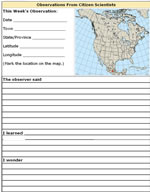|
Capturing
the Magic of Monarch Migration
Build Understanding Page-by-Page with Journey North Journals
Click
and Print
for Ready-made Journals |
 |
 |
| Journal
Cover |
Reproducible
Journal Pages |
Introduction
How can you help students collect and reflect on their experiences
with monarchs? Invite them to create a travel journal. Build understanding
and skills one page at a time. Journey North journal pages provide
a workplace where students put wondrous questions, document discoveries,
explore ever-changing events, and chronicle each step of their
scientific journey.
Teaching
Suggestions
Use these journal pages the way we designed them, or customize
to meet the needs of your students. Just click to download, open
through your Word application, and print! Or edit to enter your
own questions, categories, or layout. Students can keep their
own migration journal by following our Monarch
Butterfly Migration News Updates, and/or drawing from original
comments on the migration
maps and/or sightings
database.
-
Print a cover for each student [or have them make their own].
Grow the journal one page at a time in 3-ring binders which
become keepsake chronicles of students' scientific journey.
Journals can also be stapled, bound, or kept in each students'
pocket folder to pull out on "Journey North days."
-
Explore
the growing collection of pages to select the page that meets
your curricular goals. Each page is designed to help students
collect and reflect on information and data they find in Migration
News Updates, Observation Reports, Migration Maps, Booklets/slideshows,
and other Journey North Lessons and Resources.
-
Field
Study Pages: There are also Field Studies pages students
can use for outdoor observations. These field pages are designed
to help students draw and describe details they observe when
they collect close-up observations of plants and animals in
their natural surroundings.
-
Thematic
Journals: The
monarch migration study is rich with concrete examples of key
science concepts (such as habitat, adaptations, ecosystems,
seasons and cycles). See more tips on teaching themes and Journey
North journals: Building Understanding Through Long-term Studies.
- Rita:
To discuss: (How)do we integrate this approach
for visual observations, too? "Cultivating
Keen Observers"
Chronicle
of a Scientific Journey
Build Understanding Page-by-Page |
COLLECT |
REFLECT |
Observations
Data
Maps, Charts
Facts, Opinions
Discoveries
Photographs
Questions
Hypotheses (Predictions)
Evidence
Examples
Explanations |
Make
connections
Draw conclusions
Formulate new hypotheses
Analyze data
Generalize information
Synthesize/create
Apply |
The
Magic of Monarch Migration Journal
Page-by-Page?Explore the Possibilities! |
Migration
News Updates |
Observation
Reports
from other
Citizen Scientists |
Migration
Maps |
Collect
?All Kinds of Stuff? |
Reflect
?Think it Over? |
Collect
?All Kinds of Stuff? |
Reflect
?Think it Over? |
Collect
?All Kinds of Stuff? |
Reflect
?Think it Over? |
Excerpts
that spark interest, thought, questions, opinions
Vocabulary:
Unfamiliar Words/Concepts
Unusual
Data
Featured
Photo
Questions
Quotes
from scientists and other observers
Summary
of Highlights
|
|
Comments
from observation reports from other citizen scientists |
Calculate
data
Find
migration rates
Make
connections
Ask
questions
Formulate
hypotheses based on data
Analyze
report to extract data that is� valuable to scientists
|
|
|
Journey
North for Kids
Booklets and Slideshows |
Field
Observations |
Other
Resources |
Collect
|
Reflect
|
Collect
|
Reflect
|
Collect
|
Reflect
|
|
|
|
|
|
|
Tips
for Teachers
Use these journal pages the way we designed them, or customize
as appropriate for your class. Just click to download, open through
your Word application, and print! Or edit to enter your own questions,
categories, or layout. Students can keep their own migration journal
by following our Monarch Butterfly
Migration News Updates, and/or drawing from original comments
on the migration
maps and/or sightings
database.
-
Print a cover for each student and a stack
of journal pages. Journals can be stapled,
bound, or kept in each students' pocket folder to pull out on
"Journey North days."
-
The
map is a constant visual reminder of the geography
of migration. Students can find Mexico's winter monarch sanctuaries,
measure the distance monarchs must fly, and map the location
of migration highlights.
-
Headline is a chance for students to identify
the main idea of the week's migration news in their own creative
way.
-
Summary
is a place to sum up the news in a paragraph with supporting
details.
-
Highlights Along the Migration Trail is a category
for journal writers to focus on a bit of migration news of special
interest to them. Did they read about an unusual sighting? Enjoy
a quote? Learn something new about migration? Capture colorful
tidbits like these in the "Highlights" section. Students
can draw original comments from our migration
maps and/or sightings
database.
-
Answer our Journaling Questions that appear
in every migration update. Just flip the page over for more
space.
- Thematic
Journals The monarch migration study is rich with concrete
examples of key science concepts (such as habitat, adaptations,
ecosystems, seasons and cycles). See more tips on teaching themes
and Journey North journals: Building
Understanding Through Long-term Studies.
|
|










